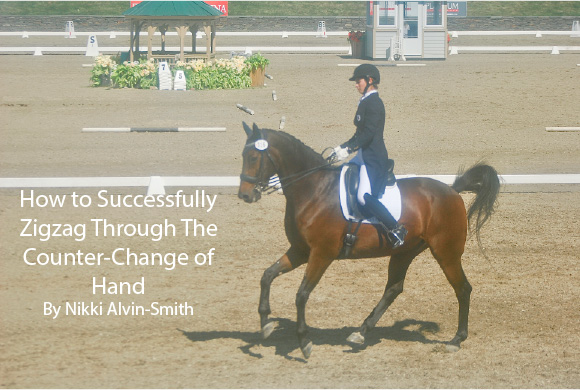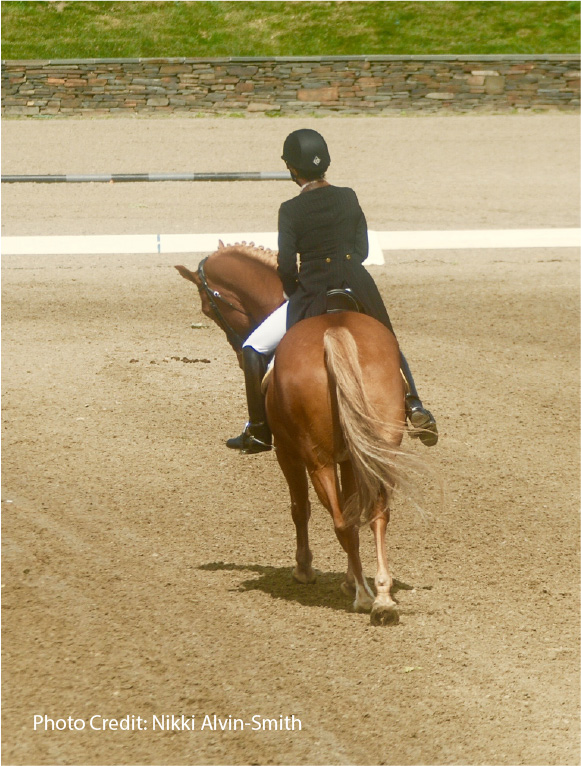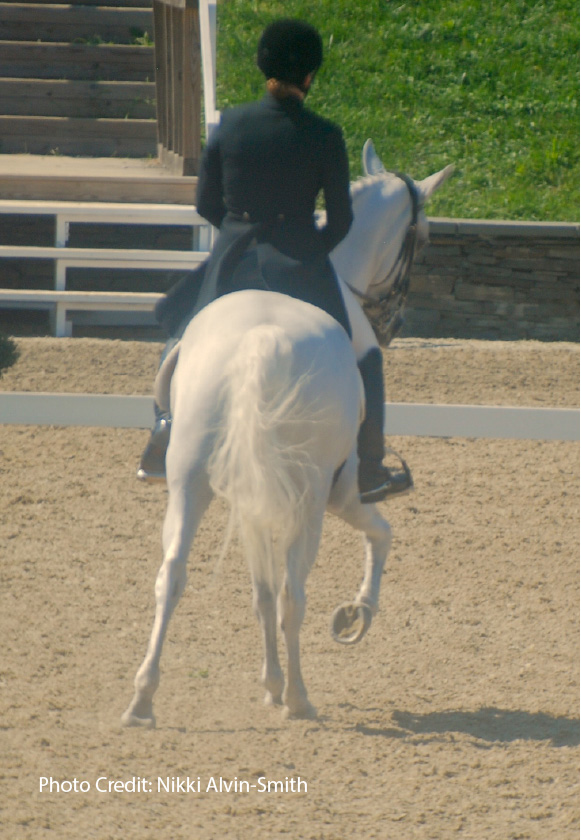How to Successfully Zigzag Through The Counter-Change of Hand
By Nikki Alvin-Smith

The counter-change of hand or zigzag is a dressage movement that can foible even the most astutely trained horse and rider. It is a true test of the lateral work that has been completed by a partnership of horse and rider to date. If you have made mistakes in the basics then you will be found out! This movement is actually fun to ride given you have the horse trained on cue and that he responds quickly to the lightest of aids. It does truly feel like you are dancing across the arena and it required in both trot and canter.
One of the hardest tests in the National Level USDF tests is Fourth Level Test 3. As this is the last National Level dressage test and is the stepping-stone to the prestigious FEI ranks, its difficulty should be embraced. So naturally it includes the zigzag, something fondly referred to as the ‘Niggli-Squiggly’ by those of us of a finer ‘age’ vintage, who remember it well from our active competition years where we were not given the option to use the side of the arena to help us change direction in the lateral movement but had to use the centerline.
Named for the legendary Swiss competitor and judge, Wolfgang Niggli. In 1964, Wolfgang Niggli became an FEI International Dressage Judge and served on the FEI Dressage Committee from 1973-1976 and again from 1979-1981. He was Chairman of the FEI Dressage Committee from 1981-1993 and remained an honorary member of the FEI Bureau until the time of his death. I was privileged to ride with this eminent horseman during clinics in my time in Switzerland with my coach Greta Kemmer. He was a kind but tough critic and 10 meter circles were one of his favorite places to discover and fix a rider or horse’s weaknesses at advanced levels.
This zigzag disappeared in USA testing for some years, but the ‘Niggli’ version is now back. You will find graduating to the ranks of FEI can be impeded by missteps in this movement.
Many riders used to dread the 2nd level tests for their difficulty and simply skip them. Riders that could lay down the pre-requisites of 4th Level Test 3 would simply skip to PSG. Interestingly you cannot make such ‘skips of convenience’ in Europe. You must proceed as a horse and rider combination up through the levels in logical sequence. If you wish to attain your USDF medals, you cannot skip them either. Anyway, the zigzag movement is there for good reason so let’s master it!
So how best can you train for it? How can you avoid costly mistakes? What can you do when things go wrong and how do you resolve the issues that may arise?
What is the Zigzag Exactly?
Lateral work is completed across short diagonals across the centerline with steps of half pass back and forth with the change of direction on the centerline. In canter the road map to each side is laid out by counting the number of strides, in trot the road map to each side is determined by distance. In the canter you must use a flying change to make your turn in direction.
Where to Start? Start With the Trot.
Young horses learning this movement will need to master the zigzag in sections and then put the jigsaw together. Obviously before you begin it is imperative that your horse can half pass both to left and right with ease and fluidity. There must be no loss of balance, trailing or leading of hindquarters, and the horse must move away from the rider’s leg with prompt obedience and without any loss of balance.
The rider will begin by working the horse in half pass for more strides than are called for in test riding because the most important thing to begin with is making a change of direction without loss of balance. It is important that the rider does not focus on just changing the bend of the neck in the change of direction for surely this will result in the horse leading with the hindquarters in the new direction.
The easiest way I’ve found to teach students is to start them out at the walk on the centerline in travers. I ask them keep the horse’s shoulders on the centerline and simply move the hindquarters from one side to the other i.e. reverse travers to the left and then to the right. This has both horse and rider immediately focused on the hind leg movement of the horse. At the beginning the rider can allow one or two steps of straightness on the centerline as this facilitates balance for the horse. Then by progression with travers from one side to the other without any straight stride the rider can know the horse is truly listening to the outside leg aid. This exercise is then repeated at the trot.
Once this is mastered the half pass can be ridden from the corner of the ring across a short diagonal to the centerline at the walk. The corner aids in maintaining the correct bend and energy of the horse which the rider has hopefully garnered from riding the short side of the arena.. At the centerline, place the horse in travers in the same direction of the half pass and ride a few strides down the center before straightening the horse on the centerline and walking forward. Once this is achieved on both reins at the walk, the same exercise may be repeated at the trot.
Start again from the corner of the arena and ride the half pass to the centerline. Then change direction toward the outside of the arena and allow the horse one straight stride before assuming the new half pass direction on the diagonal toward the wall. As you move off the centerline in your new direction push the hindquarters slightly ahead of the shoulders before the one straight stride. Again start in walk in both directions and then add in the trot.
After some correct practice you will be able to eliminate the straight stride altogether and the change of direction in the trot, or counter-change of hand will be completed. Think of this as changing your aids (reversing the aids) just before the centerline or required point of change in direction and flexing the rib cage of your horse to the other direction. If you think about this as a change in your horse’s rib cage flexion you will hopefully not be focused on just moving the horse to his new direction with heavy rein aids.
You now have key pieces to the jigsaw. It is time to work on the zigzag on the centerline.
While the test may require 5 meters each side of the centerline I don’t start by asking the horse for change of direction this quickly. You want your horse to maintain his balance and if he needs to work for more strides until it feels right to ask him to change direction then wait. As his balance improves he will soon master the shorter distances to each side of the centerline.
You should initiate the change of direction just before you hit the centerline and not just when you arrive at it. Also be certain that you start on the centerline and don’t over or undershoot it. This is of paramount importance.
The zigzag is a real test of your arena-riding prowess as you must not begin the zigzag too early or stray off the quarter lines and must be extremely accurate in your positioning throughout the movement. Use the letters wisely! They are your friends. If you miss the first position for the change of direction it will snowball as you proceed and you will find yourself in a mess by the end of the long side. Correction within the movement is hard and takes some practice.
Having Trouble?
As in any dressage training if you have difficulty take it a step back. For example if the horse can master keeping his front legs on the centerline and moving his hindquarters from left to right in the travers at the walk but not at the trot, simply go back to the walk. Then return to the trot but allow more straight strides between each travers position.
If your horse is having difficulty mastering the change of direction and flexion of his ribcage then you can work the horse from half pass to centerline, then allow him to keep the same bend but move in the new direction i.e. use counter flexion. To change direction requires a great deal of balance. A horse that is not well prepared in suppleness, straightness and correct engagement of his hind end will not be able to master it. Simply go back a few steps and find where the ‘hole’ in your training has appeared.
If you have difficulty staying ‘on track’ and not overshooting your letter marks then a great help is to lay down some shavings on the arena or use rubber cones to mark off the angles. For clinic students that have a penchant for looking down or at their horse’s ears, I have found this layout of shavings is always a great help. When harrowing your arena, always harrow the centerline last, so it is clearly evident for your schooling time.
The Canter Counter-Change of Hand
This is truly fun and I love this 4-8-8-4 stride dance. If you have good flying changes and good elevation in your canter half passes then this should not be too hard to master. As you progress through FEI it naturally becomes a harder movement with asks for 8-8-8 in Intermediare. For Grand Prix the dance becomes more difficult with three and six steps and running out of space is a real challenge as there are more changes of direction at this level. Sequence is 3-6-6-6-3.
With the basic change of hand/rein of 4-8-8-4, if you do not have your horse truly on the outside rein then you will not be able to exact the changes at the 4th and 8th strides. You must actually switch your aids just before the 3rd and 7th stride to make it happen on time. It is a good idea to switch that outside leg clearly and early to move your horse straight for the change. I have found if I actually train the movement with the horse’s hindquarters slightly leading as we near the change, it is easiest to avoid missing the change because the hindquarters won’t be trailing for the new direction of change.
The strides must be even in length and fluid and be evenly distributed to both sides of the centerline. If they are not you will miss your marks both figuratively and literally.
Let’s Master the Zigzag.
As in the trot it is fine to allow a young horse in training to work for more strides to each side and wait until you have him in good balance to ask for the change.
Once again start out simply. First, be certain you can keep your horse straight in the canter down the centerline.

As with flying changes of 4’s, 3’s, 2’s and tempi’s you must learn to count the strides from the beginning. For this exercise begin by establishing your very best collected half pass canter out of the short side of the arena to the centerline. Then ride the canter straight for four strides and then half pass to the same direction for four strides, then another four strides straight. You should have reached the side of the arena to complete those last four strides. This exercise has no flying changes. It is simply to establish the connection and obedience of the horse to your outside leg and enunciate your ability to straighten the horse and rebalance with half halts in the correct manner.
Now you are ready to complete the first jigsaw part of the counter-change of hand. Again approach the centerline from the corner coming out of the short side of the arena. Complete the same four strides as you did above and then begin to very slightly straighten your horse for a few strides as you near the centerline. Then ride a few strides completely straight on the centerline. When your horse is straight and balanced ask for a flying change to the new direction and ride diagonally in half pass toward the wall.
When this can be completed with ease in each direction you will be able to put the jigsaw together and complete the 4-8-8-4 across the centerline. You end with a nice straight line of strides to the end of the arena.
Having Trouble?
Your horse will not be able to make the flying change for the new direction if he is not straight. After strides of half pass in canter, remember you can add a few or even several strides straightforward, to ensure your horse is truly straight before making the flying change and change of direction when you in the learning stage.
A horse that is trailing in the half pass with his quarters will not be able to make a change on time. He will be late behind. He may not even be able to facilitate a change at all and the resultant push by you to make him go sideways will cause him to lose balance and of course confidence. This is loss of trust is to be avoided at all costs.
The quality of the first strides of half pass canter you exact after each change will directly determine the quality of the next half pass. You can use the trick of ensuring the quarters are slightly leading into the change, and even take the horse in a counter flexion to recheck that outside rein if you are having trouble in the change.
In conclusion, as with all lateral work, always think of it as ‘ stride forward, then sideways.’ Forward must always be your prevalent thought. If your horse is losing his balance or forward energy then ride him out of the lateral movement in a straight line and go back and try again. Be certain you are properly using your inside leg to maintain the forward energy and bend in the new direction of travel. Also be sure you are using your aids in the correct timing. Do not use your hand and leg aids at the same time. Depending on your horse you may need to use a rein aid first to one direction of change but a leg reversal aid to the other direction.

If your horse does have trouble with changing direction to one side more than the other, then this will clearly indicate you do not have the horse evenly working in both reins. Go back to basics! Shoulder in, travers, renvers and train by switching between this movements.
So you see, the counter change of hand is testing many factors of your horse’s training and this is why as a competitor, trainer and clinician I am very pleased to see it in National Level testing in both trot and canter from the centerline without the aid of the magnetic wall. The precision required in the use of the arena sets the rider up well for the tough requirements of Grand Prix.
You cannot fix an untrained horse within the movement if he makes an error. To try to do so will just unnerve him. With a highly trained horse with excellent suppleness, balance and keen understanding of the demands of the movement it is possible to make adjustments to ‘fix’ issues but the ability to exact this takes some serious earning and trust and ability on part of horse and rider.
Happy Dancing!
About the author: Nikki Alvin-Smith is an international Grand Prix dressage trainer/clinician who has competed in Europe at the Grand Prix level earning scores of over 72%. Together with her husband Paul, who is also a Grand Prix rider, they operate a private horse breeding/training farm in Stamford, NY.


